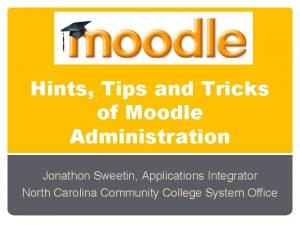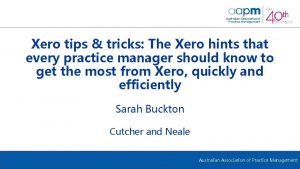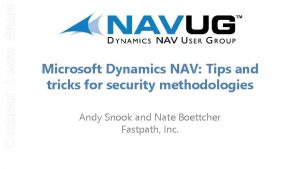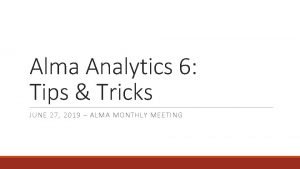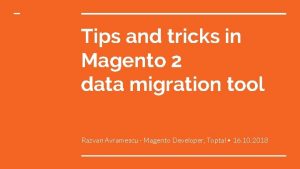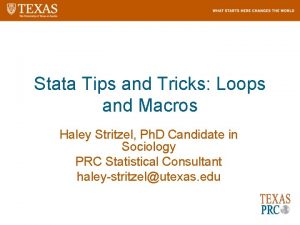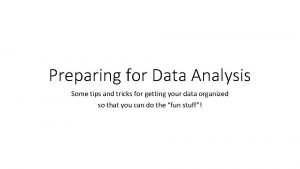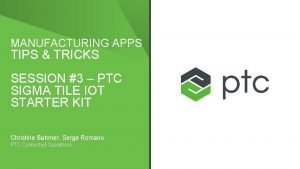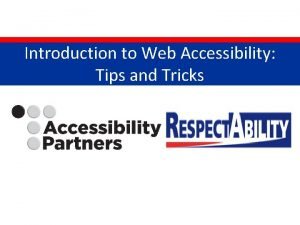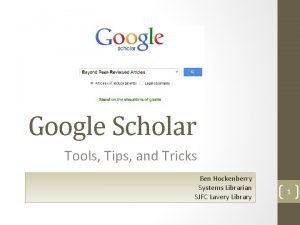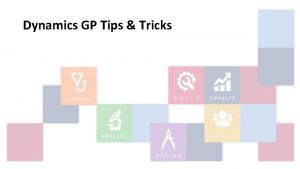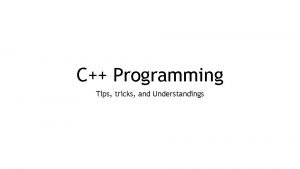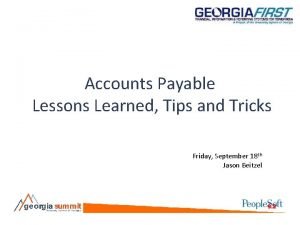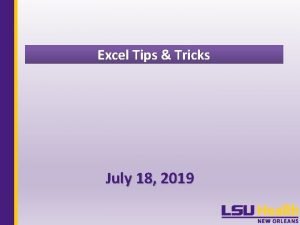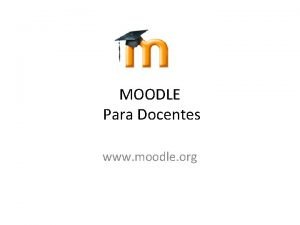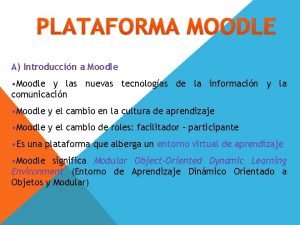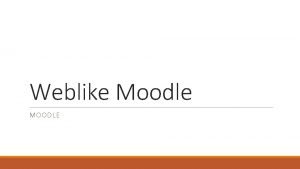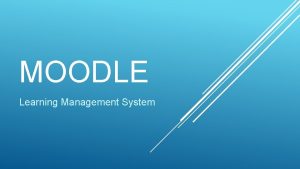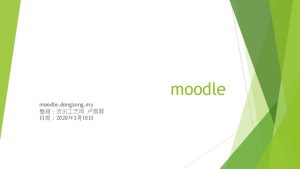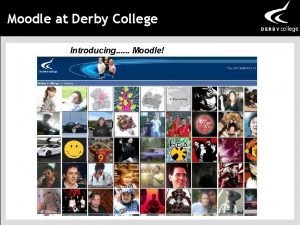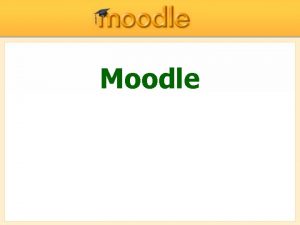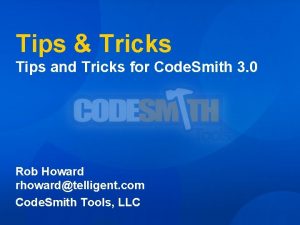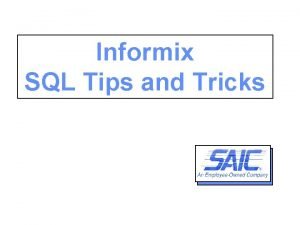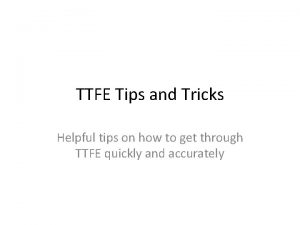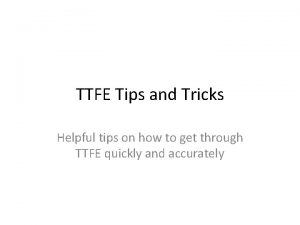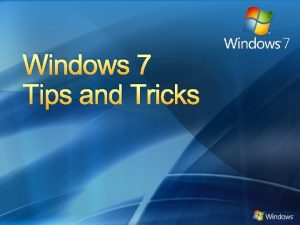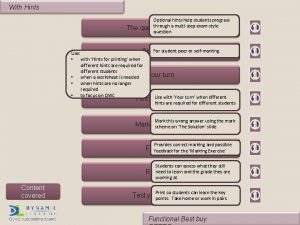Hints Tips and Tricks of Moodle Administration Jonathon


























- Slides: 26

Hints, Tips and Tricks of Moodle Administration Jonathon Sweetin, Applications Integrator North Carolina Community College System Office

Goals The goals of this presentation are: Inform Moodle administrators about changes in configuration settings that will be useful to them. Answer current Admin’s questions about Moodle functionality. Provide a resource for Moodle admins to refer to when a need arises.

Audience This presentation will be most beneficial to the experienced Moodle administrator who is comfortable making configuration changes to the application. Some of the tips in this presentation will require the Moodle admin to have access to the server backend such as FTP rights.

Overview What does a Moodle admin do? Tips on the customization • Changing the front page settings. • How to load Moodle themes. * Tips on User Management • • How to add and/or lock fields on user profiles. How to add custom fields to the students profiles. How to batch create users and enroll them into courses from a txt file. How to review student pictures in bulk.

Overview Continued Tips on Course Management • How to use meta-courses. • Moving/Restoring large courses backups Tips on Reporting • How to use Moodle reports. • How to set up Google Analytics to track your Moodle server. * Tips for Blackboard to Moodle course migration • Ways to convert courses • Using Course Conversion Tools • Using the Cut & Paste Method

Moodle System Admins In general Moodle Admins are the everyday administrators of the learning management system. Their duties may include: making course shells, uploading users, reporting, faculty training…etc. Their main way of using the learning management system (LMS) is through the Moodle admin interface. They may or may not have access to the server directly.

Customizations Changing the site front page Navigation: Admin Block> Front Page >Front Page settings There are many important setting on this screen but the one that is a little confusing is the list of courses option. The List of Courses option should be thought of as “My Courses” because it shows the student only the courses which they have been enrolled.

Customizations Loading Theme Templates* (Advanced Users Only) To load a new theme template to your Moodle server, you need: FTP Access to your Moodle server Basic understanding HTML Ability to alter images used in a theme (FTP view of Moodle server) 1. Go to Moodle. org > Downloads >Themes and download a zip file of a theme you like. 2. Upload theme files to your Moodle site’s theme folder. 3. In an images or pics folder you should find a header image and other images that you can brand with your institution’s logo. 4. Go to Admin Block>Appearance>Themes>Theme Selector to preview your new customized theme.

User Management Locking User Fields on Profiles Navigation: Admin Block> Users>Authentication>Manual accounts This tip is very helpful when a institution supplies the students with an email address that should not be changed. This will lock the field so students will not be able to change it.

User Management Adding Custom Fields to Profiles Navigation: Admin Block> Users >Accounts> User profile fields This tip is very helpful when you need to gather info about students and the field is not already supplied by Moodle. Example: Student ID #, Student Type (Con. Ed, Cur, Duel enrollment. . etc)

User Management Batch Adding Users by Flat File Navigation: Admin Block> Users >Accounts> Upload Users Example of a valid CSV import file: username, password, firstname, lastname, email, lang, idnumber, maildisplay, course 1, group 1, type 1 jonest, verysecret, Tom, Jones, jonest@someplace. edu, en, 3663737, 1, Intro 101, Section 1, 1 When you upload a formatted csv file, you can automatically enroll users into existing courses.

User Management Reviewing User Pictures If you suspect that your learners are likely to misuse the user pictures feature by uploading unsuitable pictures, you can review all uploaded user picture by go to your Moodle url>/userpix/ (a login is required). You can also disallow this functionality by going to the Admin Block>Security > Site policies and tick the Disable User Profile Images option. Warning: Once this feature is disabled, pictures cannot be assigned to any user (except the administrator) until turn back on.

Course Management Using Meta-courses A meta-course is a course that is "with" or linked to one or more courses for its student enrolment. I think is should be called meta enrollment and it does not share content between course. One way to use meta courses is in a many to one format. Hint: This set-up works well if your want students to access a resource course or orientation course.

Course Management Using Meta-courses Another way to use meta courses is in a one to many format. One parent course that auto-populates students in many child courses. Hint: This set-up works will in setting up cohort groups where all students have the same course list. (i. e. Dental Schools, Nursing Schools, Learning Communities. . etc)

Course Management Moving/Restoring Large Courses On most Moodle servers, there is an overall upload size limit on files loaded through the Moodle interface. (64 MB. . most of the time) The course backups may be larger than the upload limit. You don’t want to raise the limit too high because it will effect server performance. (Interface File Upload Tool)

Course Management Moving/Restoring Large Courses The answer is to move the backup files using server FTP and not with the file upload button. Note: If you don’t have access to your Moodle server through FTP you can always open a helpdesk ticket with your hosting vendor to have them do it for you.

Reporting Using Moodle Reports Navigation: Admin Block> Reports>Logs Reporting logs will let you view all of the user activity of your Moodle instance by date. There is also a customized 10% attendance report for reporting of DL students available. Tip: You are trying to promote interactivity in your distance learning courses, you can use the reports area to give recognition to the faculty members who have the most student activity in their courses.

Reporting Setting up Google Analytics* (Advanced Users Only) What is Google Analytics? It is a web analytics solution that gives you rich insights into your website traffic. You can setup Google Analytics to monitor your Moodle instance by following these simple steps: 1. Create an account at http: //www. Google. com/analytics/sign_up. ht ml (Note: you must have a gmail account to use analytics. )

Reporting Setting up Google Analytics* (Advanced Users Only) 2. Next, you should add a new profile (domain name) on your account to your Moodle server. You should choose the “Add a Profile for a new domain” option in the Profile Type area. You should paste the URL to your Moodle site in the field and select the correct time zone.

Reporting Setting up Google Analytics* (Advanced Users Only) 3. Next, you should cut and paste the code that Google analytics supplies into the footer. html page of theme used by your Moodle site. (FTP view of Moodle server) Google Tracking Code Page

Reporting Setting up Google Analytics* (Advanced Users Only) 3. Lastly, you should be able to view data coming from your Moodle server the day after you install the tracking code. You will be able to review info from your site in the following data set areas: • Visitors • Traffic Source • Content You can also run customized reports for cross-indexing of data.

Converting Bb courses Ways of Converting Courses There are basically two ways to convert courses from Blackboard to Moodle. 1. Using a conversion tool. (i. e. LSU) 2. Moving course files and content by hand. (cut & paste method) It is not fun either way but the method you use depends on the structure and content type in the course you wish to convert.

Converting Bb courses Using course conversion tools You can use the LSU course conversion tool at http: //Moodleconverter. lsu. edu/ if: 1. 2. 3. The Bb course has a very shallow folder structure. The Bb course is mostly text has few local files loaded into the course. (Word, Power. Point, Images…etc. ) Few quizzes or quiz pools. The LSU tool has some problems with files, quizzes, quiz pools but will re-structure a Bb course into sections well.

Converting Bb courses Using the Cut & Paste Method You should use the cut and paste method if: 1. 2. 3. The Bb course has a very deep folder structure. The Bb course is mostly files loaded into the course. (Word, Power. Point, Images…etc. ) Has many quizzes or quiz pools. Tip: Each Moodle course has a Files area that holds the files used in the course. You can load zip files directly to this area, unzip the file and the folder structure of the zip is reproduced in the course files folder.

Converting Bb courses Other Useful Conversion Tools UNC created a tool call b. Free. It is a Blackboard course archive extractor that will make a website of your blackboard course. This application helps when looking for files to load into your Moodle course files. The output of the extractor will duplicate the folder structure in your Bb course thereby adding in the file moving process.

More Resources Moodle. org Community docs. moodle. org moodle. nccomunitycolleges. edu >Moodle Users Group www. explorethelor. org North Carolina Learning Object Repository Jonathon Sweetin: Applications Integrator NCCCS System Office, 252 -737 -2766 sweetinj@nccommunitycolleges. edu
 Administration tips and tricks
Administration tips and tricks Xero tips and tricks
Xero tips and tricks Alteryx tips and tricks
Alteryx tips and tricks Next gen lab
Next gen lab Kronos tips and tricks
Kronos tips and tricks Igcse english tips
Igcse english tips Purpose of homework
Purpose of homework Navision tips and tricks
Navision tips and tricks Chemdraw stationery document
Chemdraw stationery document Alma analytics tips and tricks
Alma analytics tips and tricks Magento crud
Magento crud Stata tips and tricks
Stata tips and tricks Data analysis tricks
Data analysis tricks Matlab tips and tricks
Matlab tips and tricks Sigma tips and tricks
Sigma tips and tricks Accessibility tips and tricks
Accessibility tips and tricks Google scholar tricks
Google scholar tricks Qlik sense tips
Qlik sense tips Gp tips and tricks
Gp tips and tricks Vacuum forming companies near me
Vacuum forming companies near me C programming tips
C programming tips Accounts payable tips and tricks
Accounts payable tips and tricks Wpf tips and tricks
Wpf tips and tricks Uil mathematics scoring
Uil mathematics scoring Branding tips and tricks
Branding tips and tricks Excel tips and tricks 2019
Excel tips and tricks 2019 Kronos tips and tricks
Kronos tips and tricks
